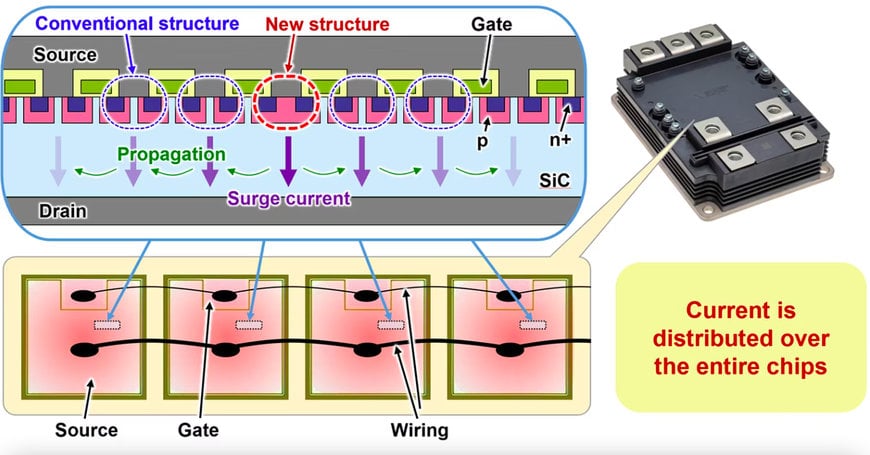electronics-journal.com
02
'23
Written on Modified on
MITSUBISHI ELECTRIC DEVELOPS SBD-EMBEDDED SIC-MOSFET WITH NEW STRUCTURE FOR POWER MODULES
The chip's new structure is expected to help downsize railway traction systems, etc. as well as make them more energy efficient, and contribute to carbon neutrality through the increased adoption of DC power transmission.

Mitsubishi Electric Corporation announced that it has developed a new structure for a silicon carbide metal-oxide-semiconductor field-effect transistor (SiC-MOSFET) embedded with a Schottky barrier diode (SBD), which the company has applied in a 3.3 kV full SiC power module, the FMF 800 DC -66 BEW for large industrial equipment such as railways and DC power systems.
SiC power semiconductors are attracting attention with their capacity to significantly reduce power loss. Mitsubishi Electric, which commercialized SiC power modules equipped with SiC-MOSFETs and SiC-SBDs in 2010, has adopted SiC power semiconductors for a variety of inverter systems, including air conditioners and railways.
The chip integrated with a SiC-MOSFET and a SiC-SBD can be mounted on a module more compactly compared to the conventional method of using separate chips, thus enabling smaller modules, larger capacity, and lower switching loss. It is expected to be widely used in large industrial equipment such as railways and electric power systems. Until now, the practical application of power modules with SBD-embedded SiC-MOSFETs has been difficult due to their relatively low surge-current capability, which results in the thermal destruction of the chips during surge-current events because surge currents in connected circuits concentrate only in specific chips.
Mitsubishi Electric has now developed the world's first mechanism by which surge current concentrates on a specific chip in a parallel-connected chip structure inside a power module, and a new chip structure in which all chips start energizing simultaneously so that surge current is distributed throughout each chip. As a result, the power module's surge-current capacity has been improved by a factor of five or more compared to the company's existing technology, which is equal to or greater than that of conventional Si power modules, thus enabling the application of an SBD-embedded SiC-MOSFET in a power module.
www.mitsubishielectric.com

